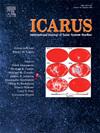Secondary scattering shape from shading for precise terrain reconstruction of the lunar permanently shadowed regions
IF 2.5
2区 物理与天体物理
Q2 ASTRONOMY & ASTROPHYSICS
引用次数: 0
Abstract
High-resolution digital elevation models (DEMs) of permanently shadowed regions (PSRs) at the lunar South Pole are crucial for upcoming exploration missions. Recent advances, such as high-resolution images acquired from ShadowCam, utilize indirect lighting to image PSRs. This provides data for the Shape from Shading (SFS) technique, which can extract subtle topographic details from single-image to reconstruct high-resolution terrain. However, traditional SFS methods are not suitable for complex secondary scattering scenes in PSRs with multiple secondary light sources. To address this issue, a novel secondary scattering SFS (SS-SFS) method is developed for pixel-wise 3D reconstruction of PSR surfaces, which utilizes indirect illuminated imagery and the corresponding low-resolution DEM to generate DEM with high resolution matches the input image. The proposed method effectively extracts and simplifies multiple incident facets associated with each shadowed facet through clustering, while constructing and optimizing the SS-SFS loss function. Experiments were conducted using ShadowCam images of two areas including both PSRs and temporary shadowed areas, to demonstrate the performance of the proposed method. The SS-SFS DEMs effectively capture intricate topographic details, and comparisons with adjusted Lunar Orbiter Laser Altimeter laser points indicate that the SS-SFS DEMs exhibit high overall accuracy. The high-resolution slope map of PSRs was calculated based on the SS-SFS DEMs, and overcome the limitation that surface slope is relatively underestimated from LOLA DEMs. Additionally, the SS-SFS DEMs were comprehensively compared with the traditional SFS DEMs generated using Narrow Angle Camera imagery in a small temporarily shadowed area, revealing strong consistency and further validating the effectiveness of detailed reconstruction. Overall, the proposed SS-SFS method is essential for generating high-resolution DEMs of PSRs, supporting future lunar South Pole exploration missions.
月球永久阴影区的二次散射形状精确地形重建
月球南极永久阴影区(PSRs)的高分辨率数字高程模型(dem)对即将到来的探测任务至关重要。最近的进展,如从ShadowCam获得的高分辨率图像,利用间接照明来成像psr。这为Shape from Shading (SFS)技术提供了数据,该技术可以从单幅图像中提取细微的地形细节,以重建高分辨率的地形。然而,传统的SFS方法不适用于具有多个二次光源的PSRs中复杂的二次散射场景。为了解决这一问题,开发了一种新的二次散射SFS (SS-SFS)方法,用于PSR表面的逐像素三维重建,该方法利用间接照明图像和相应的低分辨率DEM生成与输入图像匹配的高分辨率DEM。该方法通过聚类有效地提取和简化与每个阴影面相关联的多个事件面,同时构造和优化SS-SFS损失函数。利用ShadowCam的两个区域(psr和临时阴影区域)图像进行了实验,验证了所提方法的性能。SS-SFS dem有效地捕获了复杂的地形细节,并与调整后的月球轨道激光高度计激光点进行了比较,表明SS-SFS dem具有较高的整体精度。基于SS-SFS dem计算的PSRs高分辨率坡度图,克服了LOLA dem相对低估地表坡度的局限性。此外,将SS-SFS dem与窄角相机在小范围临时阴影区域生成的传统SFS dem进行了全面对比,显示出较强的一致性,进一步验证了详细重建的有效性。总的来说,提出的SS-SFS方法对于生成PSRs的高分辨率dem,支持未来的月球南极探测任务至关重要。
本文章由计算机程序翻译,如有差异,请以英文原文为准。
求助全文
约1分钟内获得全文
求助全文
来源期刊

Icarus
地学天文-天文与天体物理
CiteScore
6.30
自引率
18.80%
发文量
356
审稿时长
2-4 weeks
期刊介绍:
Icarus is devoted to the publication of original contributions in the field of Solar System studies. Manuscripts reporting the results of new research - observational, experimental, or theoretical - concerning the astronomy, geology, meteorology, physics, chemistry, biology, and other scientific aspects of our Solar System or extrasolar systems are welcome. The journal generally does not publish papers devoted exclusively to the Sun, the Earth, celestial mechanics, meteoritics, or astrophysics. Icarus does not publish papers that provide "improved" versions of Bode''s law, or other numerical relations, without a sound physical basis. Icarus does not publish meeting announcements or general notices. Reviews, historical papers, and manuscripts describing spacecraft instrumentation may be considered, but only with prior approval of the editor. An entire issue of the journal is occasionally devoted to a single subject, usually arising from a conference on the same topic. The language of publication is English. American or British usage is accepted, but not a mixture of these.
 求助内容:
求助内容: 应助结果提醒方式:
应助结果提醒方式:


